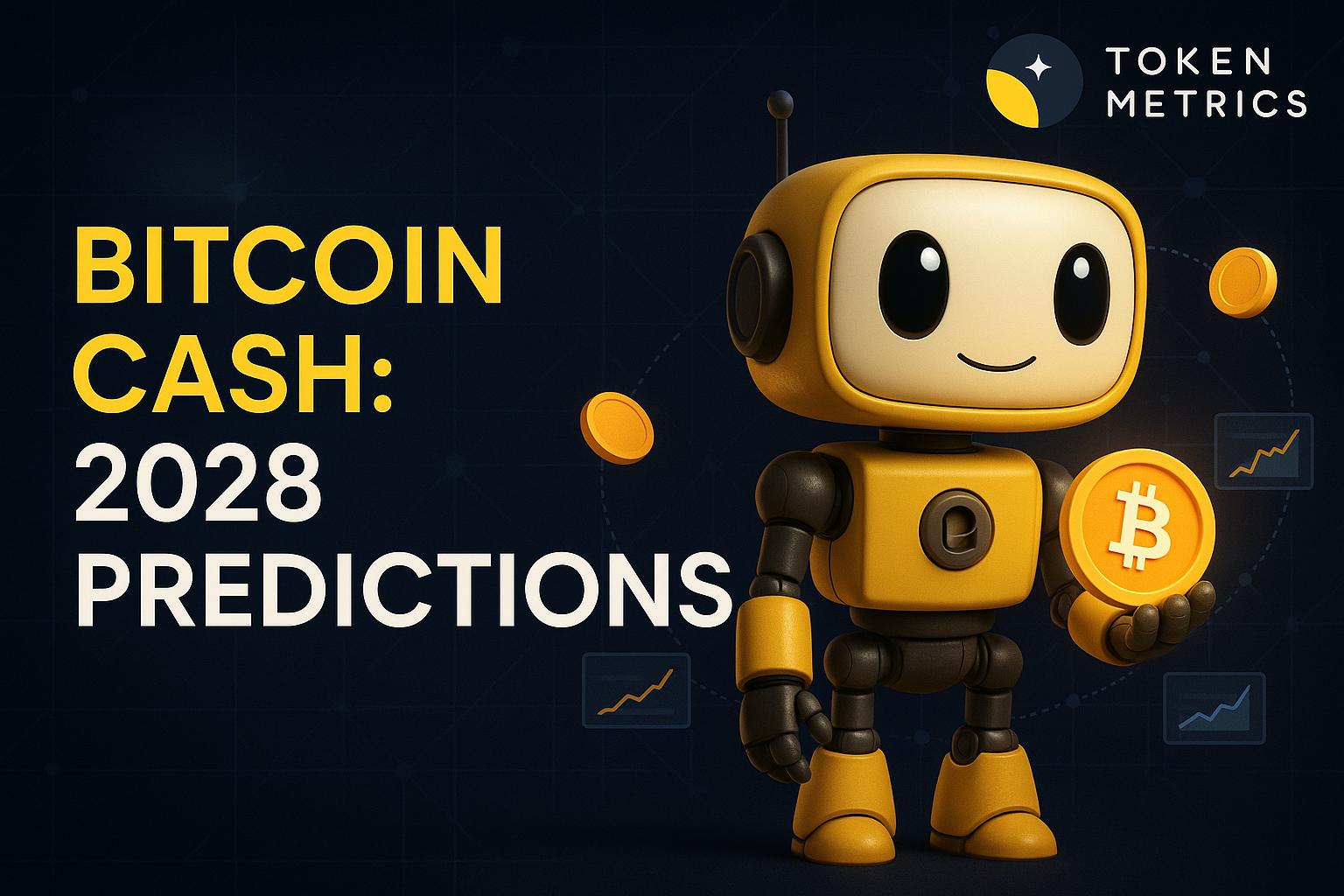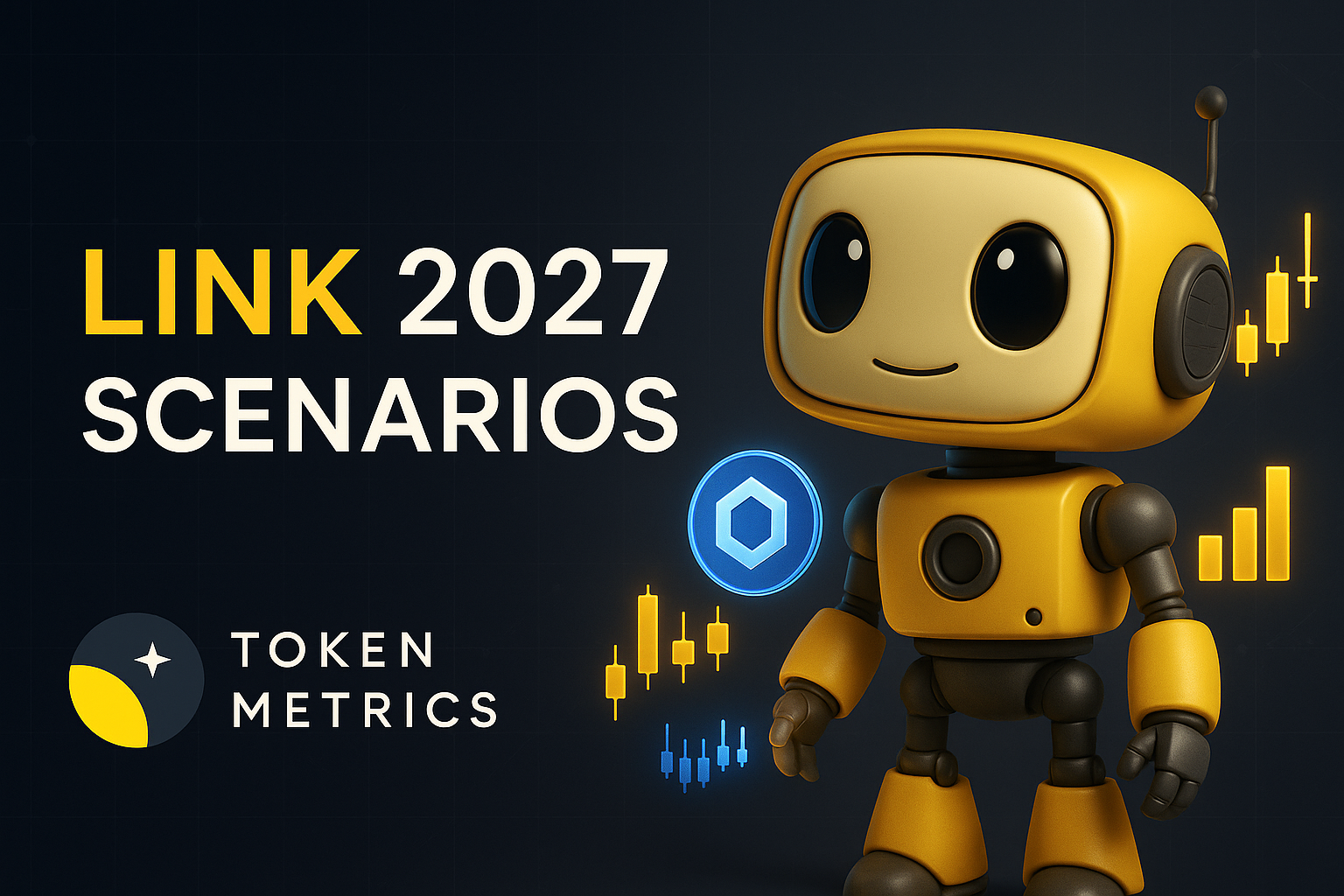Top Crypto Trading Platforms in 2025







%201.svg)
%201.svg)
Big news: We’re cranking up the heat on AI-driven crypto analytics with the launch of the Token Metrics API and our official SDK (Software Development Kit). This isn’t just an upgrade – it's a quantum leap, giving traders, hedge funds, developers, and institutions direct access to cutting-edge market intelligence, trading signals, and predictive analytics.
Crypto markets move fast, and having real-time, AI-powered insights can be the difference between catching the next big trend or getting left behind. Until now, traders and quants have been wrestling with scattered data, delayed reporting, and a lack of truly predictive analytics. Not anymore.
The Token Metrics API delivers 32+ high-performance endpoints packed with powerful AI-driven insights right into your lap, including:
Getting started with the Token Metrics API is simple:
At Token Metrics, we believe data should be decentralized, predictive, and actionable.
The Token Metrics API & SDK bring next-gen AI-powered crypto intelligence to anyone looking to trade smarter, build better, and stay ahead of the curve. With our official SDK, developers can plug these insights into their own trading bots, dashboards, and research tools – no need to reinvent the wheel.
%201.svg)
%201.svg)
Infrastructure protocols become more valuable as the crypto ecosystem scales and relies on robust middleware. Chainlink provides critical oracle infrastructure where proven utility and deep integrations drive long-term value over retail speculation. Increasing institutional adoption raises demand for professional-grade data delivery and security.
Token Metrics projections for LINK below span multiple total market cap scenarios from conservative to aggressive. Each tier assumes different levels of infrastructure demand as crypto evolves from speculative markets to institutional-grade systems. These bands frame LINK's potential outcomes into 2027.

Disclosure
Educational purposes only, not financial advice. Crypto is volatile, do your own research and manage risk.
How to read it: Each band blends cycle analogues and market-cap share math with TA guardrails. Base assumes steady adoption and neutral or positive macro. Moon layers in a liquidity boom. Bear assumes muted flows and tighter liquidity.
TM Agent baseline: Token Metrics lead metric for Chainlink, cashtag $LINK, is a TM Grade of 23.31%, which translates to a Sell, and the trading signal is bearish, indicating short-term downward momentum. This means Token Metrics currently does not endorse $LINK as a long-term buy at current conditions.
Live details: Chainlink Token Details
Affiliate Disclosure: We may earn a commission from qualifying purchases made via this link, at no extra cost to you.
Token Metrics scenarios span four market cap tiers, each representing different levels of crypto market maturity and liquidity:
8T: At an 8 trillion dollar total crypto market cap, LINK projects to $26.10 in bear conditions, $30.65 in the base case, and $35.20 in bullish scenarios.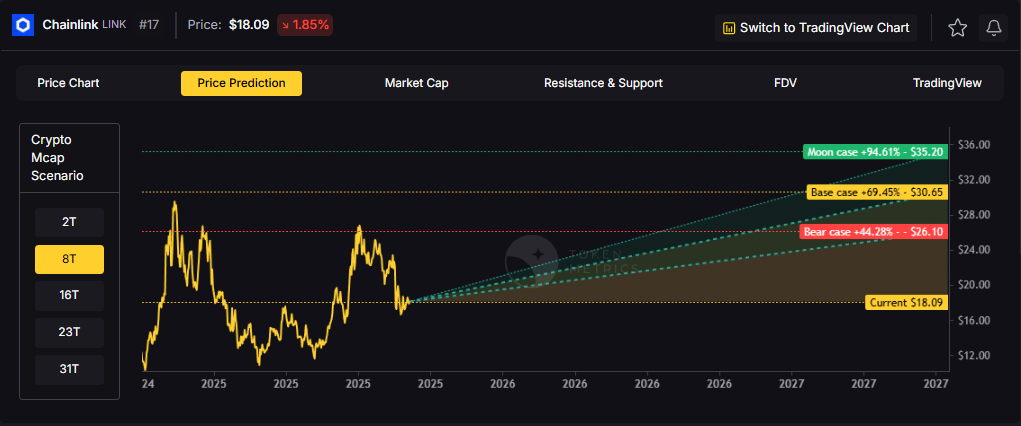
16T: Doubling the market to 16 trillion expands the range to $42.64 (bear), $56.29 (base), and $69.95 (moon).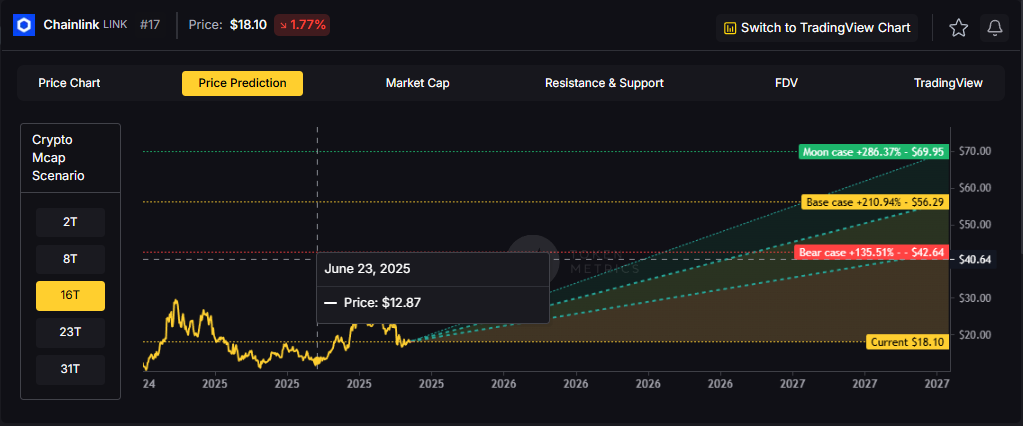
23T: At 23 trillion, the scenarios show $59.18, $81.94, and $104.70 respectively.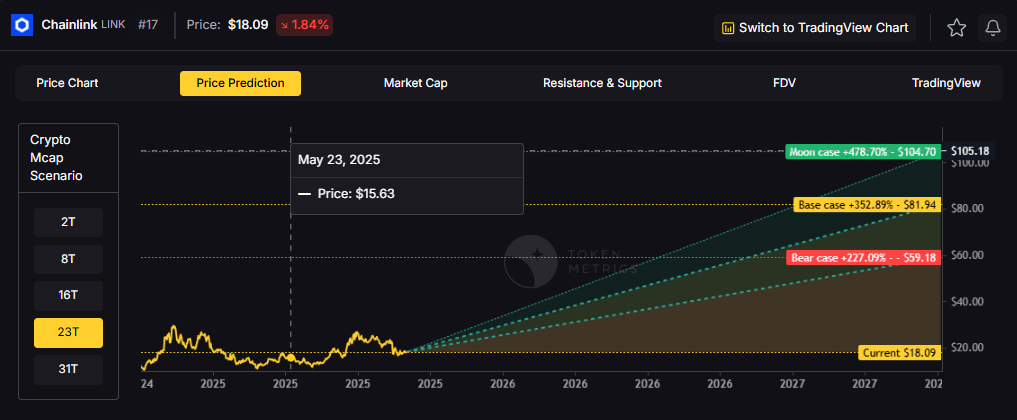
31T: In the maximum liquidity scenario of 31 trillion, LINK could reach $75.71 (bear), $107.58 (base), or $139.44 (moon).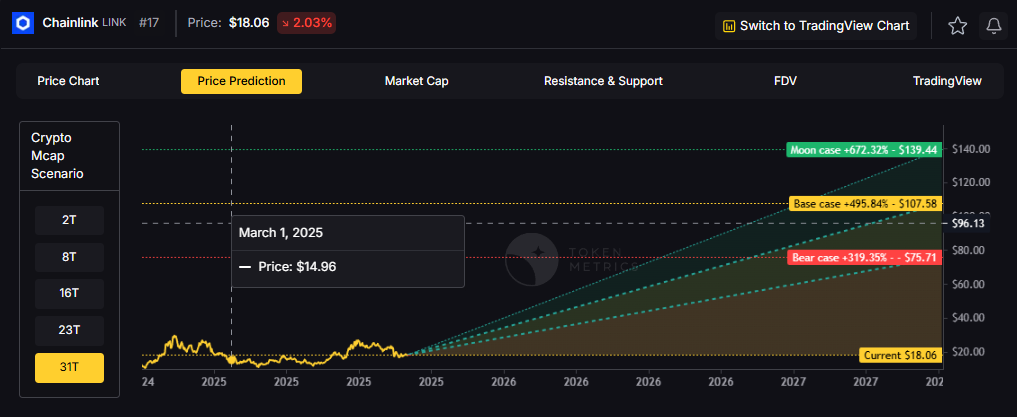
Chainlink represents one opportunity among hundreds in crypto markets. Token Metrics Indices bundle LINK with top one hundred assets for systematic exposure to the strongest projects. Single tokens face idiosyncratic risks that diversified baskets mitigate.
Historical index performance demonstrates the value of systematic diversification versus concentrated positions.
Chainlink is a decentralized oracle network that connects smart contracts to real-world data and systems. It enables secure retrieval and verification of off-chain information, supports computation, and integrates across multiple blockchains. As adoption grows, Chainlink serves as critical infrastructure for reliable data feeds and automation.
The LINK token is used to pay node operators and secure the network’s services. Common use cases include DeFi price feeds, insurance, and enterprise integrations, with CCIP extending cross-chain messaging and token transfers.
Vision: Chainlink aims to create a decentralized, secure, and reliable network for connecting smart contracts with real-world data and systems. Its vision is to become the standard for how blockchains interact with external environments, enabling trust-minimized automation across industries.
Problem: Smart contracts cannot natively access data outside their blockchain, limiting their functionality. Relying on centralized oracles introduces single points of failure and undermines the security and decentralization of blockchain applications. This creates a critical need for a trustless, tamper-proof way to bring real-world information onto blockchains.
Solution: Chainlink solves this by operating a decentralized network of node operators that fetch, aggregate, and deliver data from off-chain sources to smart contracts. It uses cryptographic proofs, reputation systems, and economic incentives to ensure data integrity. The network supports various data types and computation tasks, allowing developers to build complex, data-driven decentralized applications.
Market Analysis: Chainlink is a market leader in the oracle space and a key infrastructure component in the broader blockchain ecosystem, particularly within Ethereum and other smart contract platforms. It faces competition from emerging oracle networks like Band Protocol and API3, but maintains a strong first-mover advantage and widespread integration across DeFi, NFTs, and enterprise blockchain solutions. Adoption is driven by developer activity, partnerships with major blockchain projects, and demand for secure data feeds. Key risks include technological shifts, regulatory scrutiny on data providers, and execution challenges in scaling decentralized oracle networks. As smart contract usage grows, so does the potential for oracle services, positioning Chainlink at the center of a critical niche, though its success depends on maintaining security and decentralization over time.
Fundamental Grade: 74.58% (Community 81%, Tokenomics 100%, Exchange 100%, VC —, DeFi Scanner 17%).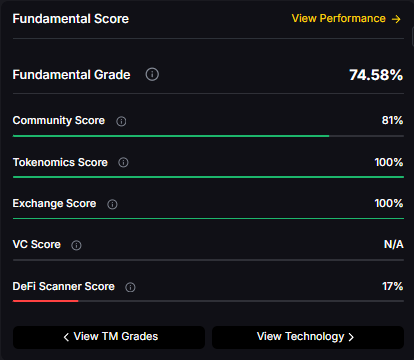
Technology Grade: 88.50% (Activity 81%, Repository 72%, Collaboration 100%, Security 86%, DeFi Scanner 17%).
Can LINK reach $100?
Yes. Based on the scenarios, LINK could reach $100+ in the 23T moon case. The 23T tier projects $104.70 in the moon case. Not financial advice.
What price could LINK reach in the moon case?
Moon case projections range from $35.20 at 8T to $139.44 at 31T. These scenarios assume maximum liquidity expansion and strong Chainlink adoption. Not financial advice.
Should I buy LINK now or wait?
Timing depends on risk tolerance and macro outlook. Current price of $18.09 sits below the 8T bear case in the scenarios. Dollar-cost averaging may reduce timing risk. Not financial advice.
Track live grades and signals: Token Details
Want exposure? Buy LINK on MEXC
Disclosure
Educational purposes only, not financial advice. Crypto is volatile, do your own research and manage risk.
Discover the full potential of your crypto research and portfolio management with Token Metrics. Our ratings combine AI-driven analytics, on-chain data, and decades of investing expertise—giving you the edge to navigate fast-changing markets. Try our platform to access scenario-based price targets, token grades, indices, and more for institutional and individual investors. Token Metrics is your research partner through every crypto market cycle.
%201.svg)
%201.svg)
The crypto market is tilting bullish into 2026 as liquidity, infrastructure, and participation improve across the board. Clearer rules and standards are reshaping the classic four-year cycle, flows can arrive earlier, and strength can persist longer than in prior expansions.
Institutional access is widening through ETFs and custody, while L2 scaling and real-world integrations help sustain on‑chain activity. This healthier backdrop frames our scenario work for HYPE. The ranges below reflect different total crypto market sizes and the share Hyperliquid could capture under each regime.
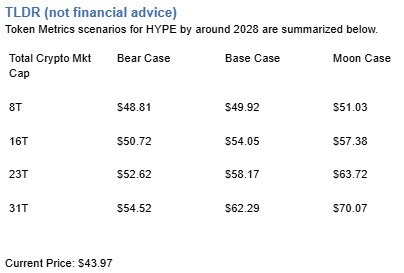
Disclosure
Educational purposes only, not financial advice. Crypto is volatile, do your own research and manage risk.
How to read it: Each band blends cycle analogues and market-cap share math with TA guardrails. Base assumes steady adoption and neutral or positive macro. Moon layers in a liquidity boom. Bear assumes muted flows and tighter liquidity.
TM Agent baseline: Token Metrics TM Grade is 73.9%, a Buy, and the trading signal is bearish, indicating short-term downward momentum. This means Token Metrics judges HYPE as fundamentally attractive over the long term, while near-term momentum is negative and may limit rallies.
Live details: Hyperliquid Token Details
Affiliate Disclosure: We may earn a commission from qualifying purchases made via this link, at no extra cost to you.
Scenario Analysis
Token Metrics scenarios span four market cap tiers, each representing different levels of crypto market maturity and liquidity:
8T: At an 8 trillion dollar total crypto market cap, HYPE projects to $48.81 in bear conditions, $49.92 in the base case, and $51.03 in bullish scenarios.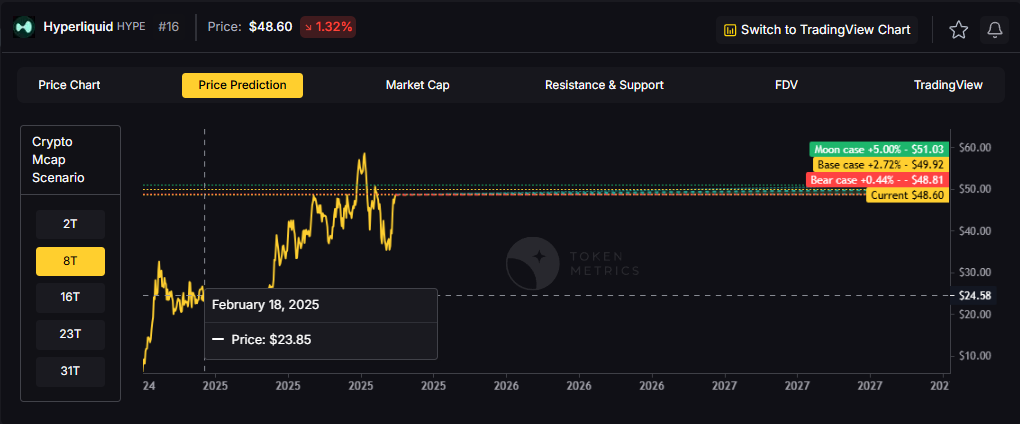
16T: Doubling the market to 16 trillion expands the range to $50.72 (bear), $54.05 (base), and $57.38 (moon).
23T: At 23 trillion, the scenarios show $52.62, $58.17, and $63.72 respectively.
31T: In the maximum liquidity scenario of 31 trillion, HYPE could reach $54.52 (bear), $62.29 (base), or $70.07 (moon).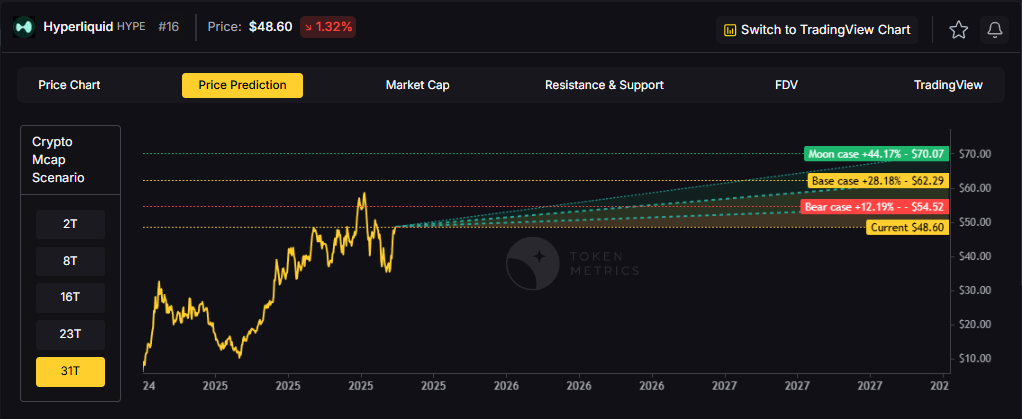
Each tier assumes progressively stronger market conditions, with the base case reflecting steady growth and the moon case requiring sustained bull market dynamics.
Diversification matters. HYPE is compelling, yet concentrated bets can be volatile. Token Metrics Indices hold HYPE alongside the top one hundred tokens for broad exposure to leaders and emerging winners.
Our backtests indicate that owning the full market with diversified indices has historically outperformed both the total market and Bitcoin in many regimes due to diversification and rotation.
Hyperliquid is a decentralized exchange focused on perpetual futures with a high-performance order book architecture. The project emphasizes low-latency trading, risk controls, and capital efficiency aimed at professional and retail derivatives traders. Its token, HYPE, is used for ecosystem incentives and governance-related utilities.
Can HYPE reach $60?
Yes, the 23T and 31T tiers imply ranges above $60 in the Base and Moon bands, though outcomes depend on liquidity and adoption. Not financial advice.
Is HYPE a good long-term investment?
Outcome depends on adoption, liquidity regime, competition, and supply dynamics. Diversify and size positions responsibly.
Disclosure
Educational purposes only, not financial advice. Crypto is volatile, do your own research and manage risk.
Token Metrics delivers AI-based crypto ratings, scenario projections, and portfolio tools so you can make smarter decisions. Discover real-time analytics on Token Metrics.
%201.svg)
%201.svg)
The Layer 1 competitive landscape is consolidating as markets recognize that specialization matters more than being a generic "Ethereum killer." Cardano positions itself in this multi-chain world with specific technical and ecosystem advantages. Infrastructure maturity around custody, bridges, and developer tools makes alternative L1s more accessible heading into 2026.
The scenario projections below map different market share outcomes for ADA across varying total crypto market sizes. Base cases assume Cardano maintains current ecosystem momentum, while moon scenarios factor in accelerated adoption and bear cases reflect increased competitive pressure.

Disclosure
Educational purposes only, not financial advice. Crypto is volatile, do your own research and manage risk.
How to read it: Each band blends cycle analogues and market-cap share math with TA guardrails. Base assumes steady adoption and neutral or positive macro. Moon layers in a liquidity boom. Bear assumes muted flows and tighter liquidity.
TM Agent baseline: Token Metrics lead metric for Cardano, cashtag $ADA, is a TM Grade of 29.72%, which translates to a Sell, and the trading signal is bearish, indicating short-term downward momentum. This combination means Token Metrics does not currently endorse $ADA as a long-term buy at current levels. A brief market context: Bitcoin's direction remains the dominant macro driver for smart contract platforms, so sustained upside for $ADA would require a broader crypto risk-on regime and improving fundamentals or developer activity for Cardano.
Live details: Cardano Token Details
Affiliate Disclosure: We may earn a commission from qualifying purchases made via this link, at no extra cost to you.
Token Metrics scenarios span four market cap tiers, each representing different levels of crypto market maturity and liquidity:




Each tier assumes progressively stronger market conditions, with the base case reflecting steady growth and the moon case requiring sustained bull market dynamics.
Cardano represents one opportunity among hundreds in crypto markets. Token Metrics Indices bundle ADA with top one hundred assets for systematic exposure to the strongest projects. Single tokens face idiosyncratic risks that diversified baskets mitigate.
Historical index performance demonstrates the value of systematic diversification versus concentrated positions.
Cardano is a blockchain platform designed to support secure, scalable, and sustainable decentralized applications and smart contracts. It is known for its research-driven development approach, emphasizing peer-reviewed academic research and formal verification methods to ensure reliability and security. As a proof-of-stake Layer 1 blockchain, Cardano aims to offer energy efficiency and long-term scalability, positioning itself as a competitor to platforms like Ethereum. Its native token, ADA, is used for transactions, staking, and governance. Adoption is driven by technological rigor and ecosystem growth, though progress has been criticized for being slow compared to more agile competitors. Risks include execution delays, competition, and market volatility.
Cardano’s vision is to create a decentralized platform that enables sustainable and inclusive economic systems through advanced cryptography and scientific methodology. It aims to bridge gaps between traditional financial systems and blockchain technology, promoting accessibility and security for users globally.
Token Metrics AI provides comprehensive context on Cardano's positioning and challenges.


Can ADA reach $4?
Based on the scenarios, ADA could reach $4 in the 31T moon case. The 31T tier projects $4.27 in the moon case. Not financial advice.
Can ADA 10x from current levels?
At current price of $0.65, a 10x would reach $6.50. This falls within none of the provided scenarios, which top out at $4.27 in the 31T moon case. Bear in mind that 10x returns require substantial market cap expansion. Not financial advice.
What price could ADA reach in the moon case?
Moon case projections range from $1.16 at 8T to $4.27 at 31T. These scenarios assume maximum liquidity expansion and strong Cardano adoption. Not financial advice.
Disclosure
Educational purposes only, not financial advice. Crypto is volatile, do your own research and manage risk.

%201.svg)
%201.svg)
Understanding price trends and market dynamics is essential for researchers, developers, and analysts working in the cryptocurrency ecosystem. The demand for actionable, reliable historical crypto data has surged as more professionals seek to power apps, AI agents, and dashboards with accurate blockchain information. But how can you easily access robust historical data—from Bitcoin’s early days to today—using an API?
Historical crypto data serves multiple critical roles in the blockchain and digital asset space. It is the foundation for backtesting trading algorithms, visualizing price trends, and conducting academic or business-driven research on market cycles. Given cryptocurrencies’ rapid global growth, time series data helps users:
Yet with thousands of coins traded across dozens of exchanges since 2009, acquiring comprehensive, accurate history is challenging without programmatic tools like APIs.
An Application Programming Interface (API) acts as a bridge, allowing your software to interact with data providers’ servers in real time or on demand. For historical cryptocurrency data, APIs typically offer endpoints for retrieving:
Data is returned in structured formats like JSON or CSV, ideal for integration with research notebooks, dashboards, and machine learning pipelines. API providers may cover dozens or hundreds of exchanges, aggregate data, or focus on specific subsets of assets.
With a crowded crypto data landscape, selecting the best API depends on your use case and quality requirements. Consider evaluating providers by:
Token Metrics and a few other advanced platforms provide comprehensive coverage alongside AI-driven analytics that can integrate seamlessly with research or engineering workflows.
Fetching crypto history using an API typically involves several common steps:
/historical/prices)For example, you can retrieve daily Bitcoin OHLC data from a well-documented endpoint and use it in pandas to build price charts, calculate volatility, or feed into a machine learning model. Programmatic access ensures you can automate research, power trading dashboards, or compare assets historically without manual downloads or spreadsheet wrangling.
Combining robust historical data APIs with AI-powered analytics unlocks new potential for crypto research. Platforms like Token Metrics utilize large datasets not just for presenting history, but for generating intelligence: pattern recognition, trading signals, anomaly detection, and fundamental scoring. By integrating API live feeds with AI models, you can:
This workflow ensures analysts, quant researchers, and builders can move from raw blockchain data to actionable insights efficiently, while focusing on accuracy and reproducibility.
Build Smarter Crypto Apps & AI Agents with Token Metrics
Token Metrics provides real-time prices, trading signals, and on-chain insights all from one powerful API. Grab a Free API Key
APIs give you programmatic access to a variety of historical data: price OHLCV (Open, High, Low, Close, Volume), order book snapshots, tick-by-tick trades, market capitalization, on-chain metrics, and more. The granularity and range depend on the specific API provider.
Yes, several APIs (including entry-level tiers from advanced providers) offer free endpoints for historical prices and market data. However, free plans may limit data granularity, history depth, or request frequency compared to paid subscriptions.
APIs vary: Bitcoin data typically goes back to 2010, while Ethereum and other major coins cover several years. Full coverage for all coins and smaller assets may depend on the exchange and the API provider’s archival policies.
Absolutely. Clean, granular API feeds are essential for training, validating, and deploying machine learning models for trend detection, price prediction, and anomaly analysis. Many platforms now deliver AI-ready historical crypto data to streamline these workflows.
Most APIs return data as JSON or CSV, which can be fetched and handled with Python (using requests or httpx packages), JavaScript/TypeScript, Java, or Go. Providers often supply SDKs and code examples for easy onboarding.
This blog post is provided for educational and informational purposes only. It does not offer investment advice or endorse any specific assets, services, or platforms. Always conduct independent research and review provider documentation before making technical or business decisions related to APIs and crypto data.
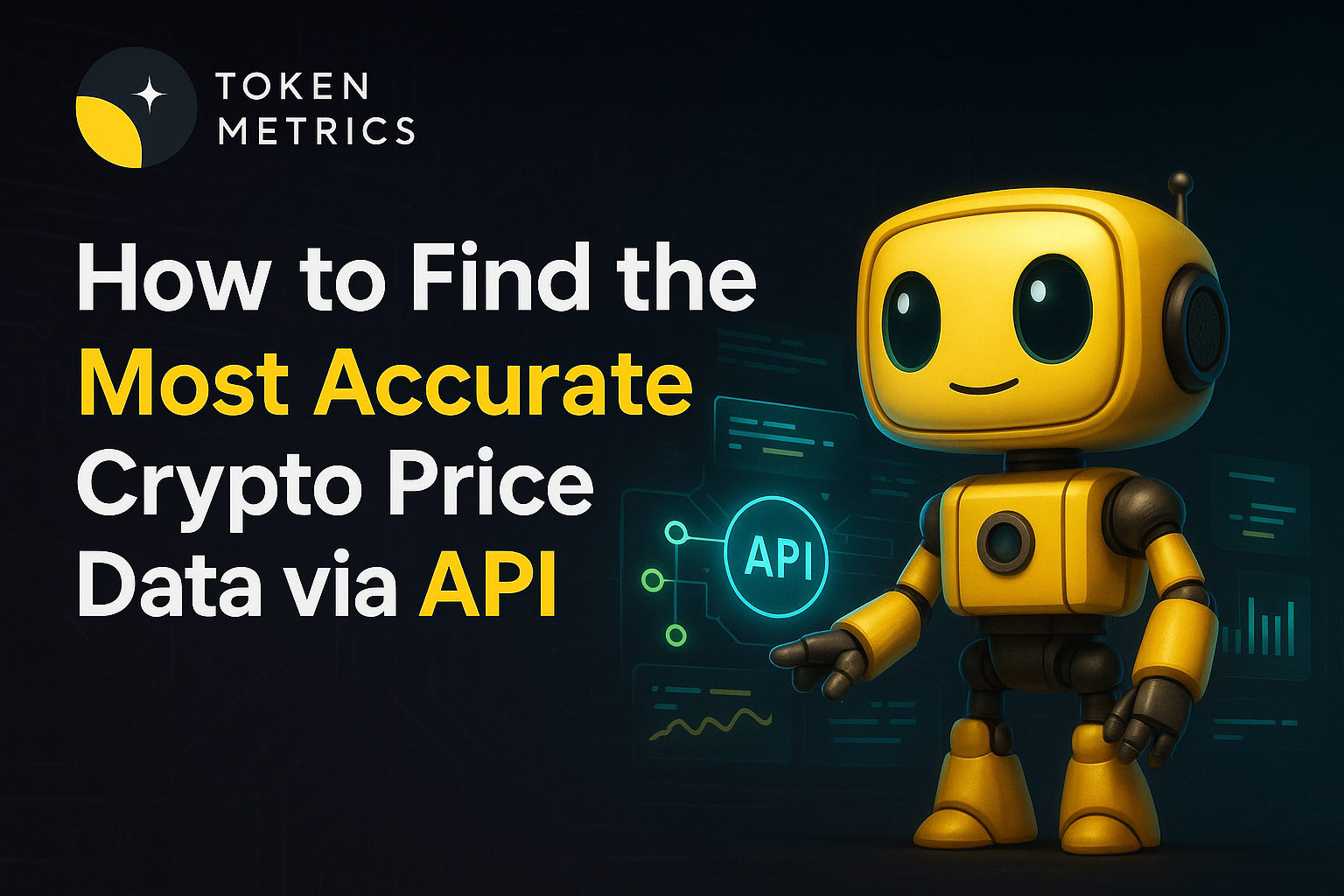
%201.svg)
%201.svg)
The search for reliable, real-time cryptocurrency price data is a common challenge for developers, analysts, and researchers in the digital asset space. With hundreds of active crypto exchanges and significant price discrepancies across platforms, choosing the right API can make or break your crypto app or data-driven workflow. But which crypto API actually delivers the most accurate price data?
Whether you're building an app for portfolio tracking, algorithmic trading, DeFi analytics, or AI-powered crypto agents, precision in price feeds is critical. Inaccurate or delayed data can lead to flawed models, missed opportunities, or even compliance issues for institutional players. Since the crypto market is decentralized and fragmented, no single exchange houses the universally accepted price for Bitcoin or any other token. As a result, APIs aggregate data differently—some provide an average price across several exchanges, while others pick a primary source. How an API compiles and updates prices determines its accuracy and reliability.
Not all crypto price APIs are created equal. Understanding the different types can help you match your needs with the right provider:
When choosing a crypto price API, consider whether you need spot pricing, historical data, liquidity-weighted averages, or normalized feeds for your use case.
Comparing API providers involves more than just looking at their exchange list. Here are the most important variables to assess:
Many serious projects also look for compliance features, such as market surveillance and anti-manipulation policies, though this is more relevant for enterprise integrations than hobby projects.
Based on public documentation, developer feedback, and recent reliability tests, here are five of the most widely used crypto price APIs and how they address accuracy:
No single provider is the "ultimate source"—trade-offs between speed, coverage, and cost exist. For most AI, DeFi, or advanced analytics projects, combining a trusted aggregator (like the Token Metrics API) with cross-references from single-exchange feeds offers a best-practice approach to price accuracy.
To ensure the highest price accuracy in your crypto app or data science workflow, keep these best practices in mind:
Ultimately, the API you choose should align with your use case—whether that's an AI-powered agent making split-second decisions, a portfolio dashboard for long-term holders, or a research tool tracking historical price shifts at scale.
Build Smarter Crypto Apps & AI Agents with Token Metrics
Token Metrics provides real-time prices, trading signals, and on-chain insights all from one powerful API. Grab a Free API Key
A crypto price API is a programmatic interface that allows apps and tools to access up-to-date digital asset price data from exchanges and aggregators. Developers use these APIs to retrieve spot prices, historical data, and market statistics, improving the responsiveness and accuracy of crypto-enabled products.
Most aggregator APIs use liquidity- and volume-weighted averages from multiple exchanges to provide representative prices. Leading providers employ filters to exclude abnormal data, detect outliers, and update the source list regularly to reflect top-performing exchanges. Documentation should always be reviewed for each provider's methodology.
For research, broad coverage and rich historical data (e.g., CoinGecko, Token Metrics) are important. For trading, prioritized speed, low-latency feeds (such as those from Token Metrics, Kaiko, or direct exchange APIs), and advanced analytics/tooling are key. Many professionals use both types: one for research, and one for live trading signals.
Free APIs can provide reasonably accurate prices, especially for widely traded assets like Bitcoin and Ethereum. However, they may offer lower rate limits, slower updates, or less historical depth than premium options. For critical or business applications, upgrading to a paid plan with greater support and data guarantees is advisable.
Update frequency varies: some APIs refresh data every few seconds, while others provide real-time data through streaming (WebSocket) feeds. For fast-moving markets, always check the provider's documentation for precise update intervals.
This article is for informational and educational purposes only and does not constitute financial or investment advice. Always conduct your own research and consult a qualified professional for guidance specific to your situation.

%201.svg)
%201.svg)
The explosion of digital assets has fueled a new era of on-demand data analysis, making crypto APIs essential for enthusiasts, developers, and analysts alike. But what kinds of information can you actually unlock using a crypto API, and how can this data power smarter apps or research?
One of the most popular uses for a crypto API is accessing real-time pricing data. APIs enable you to pull the latest prices for thousands of cryptocurrencies across multiple exchanges instantly. This information is foundational for market analysis, digital asset tracking, and powering portfolio dashboards.
Most leading APIs, such as the Token Metrics API, offer live pricing feeds for efficient decision-making and data integration.
Reliable historical data is key to uncovering trends, backtesting strategies, and building machine learning models. Crypto APIs typically allow you to pull:
Historical endpoints help quant researchers and developers build accurate visualizations and statistical models. For instance, analyzing 365 days of closing prices can reveal volatility patterns or market cycles.
Order book data provides the pulse of live trading activity, revealing granular details about market depth and liquidity. With a crypto API, you can access:
Order book access is crucial for algorithmic trading, slippage estimates, and evaluating liquidity. Some APIs even support aggregated order books across several exchanges for more complete market intelligence.
In addition to static prices, many crypto APIs deliver real-time trade and ticker data. This includes:
Use cases range from powering trading bots to feeding AI-driven analytics or anomaly detection systems. This granularity allows a deeper understanding of real-time market sentiment.
Beyond market data, advanced crypto APIs now offer direct access to blockchain or on-chain data. Developers and analysts gain the ability to:
Such on-chain analytics underpin advanced research, compliance processes, and fraud detection strategies. APIs that aggregate insights across multiple blockchains add significant value for multi-asset and multi-chain projects.
Build Smarter Crypto Apps & AI Agents with Token Metrics
Token Metrics provides real-time prices, trading signals, and on-chain insights all from one powerful API. Grab a Free API Key
Most crypto APIs supply real-time prices, trading volume, order books, and historical price/volume data. Some also cover blockchain transactions and wallet-level insights—useful for a range of research and app development scenarios.
Leading crypto APIs aggregate data from various exchanges, allowing developers and analysts to access consolidated prices, order books, and liquidity. Aggregated APIs minimize discrepancies and broaden coverage.
The available historical depth varies; top APIs like Token Metrics offer years of daily price data, with some offering tick-level data spanning months or years. Always review documentation for specific asset or interval support.
APIs allow for automated retrieval, filtering, and analysis of large datasets—enhancing research, powering trading robots, building dashboards, or supporting AI-driven models with up-to-date, reliable information.
On-chain data enables compliance monitoring, wallet tracking, DeFi analytics, NFT research, contract auditing, and forensic investigations. Modern APIs help analysts and businesses stay agile amid evolving blockchain trends.
This article is for informational purposes only and does not constitute investment, financial, legal, or tax advice. Cryptocurrency markets are volatile and involve risks. Always conduct your own research before making decisions or building applications based on crypto data.

%201.svg)
%201.svg)
As the cryptocurrency landscape grows more complex, developers and businesses increasingly rely on crypto APIs to access data, power apps, and build innovative blockchain solutions. But a common question arises: are crypto APIs free, or will you need to pay to unlock full functionality?
Crypto APIs (Application Programming Interfaces) act as critical gateways to blockchain data, facilitating seamless integration with cryptocurrency exchanges, wallets, smart contracts, and on-chain analytics. Whether you're building a trading bot, a portfolio dashboard, or financial analytics tools, APIs provide the technical means to fetch real-time prices, historical data, market signals, and transaction details.
For developers and enterprises, leveraging APIs saves hundreds of hours that would otherwise be spent running full blockchain nodes or parsing raw blockchain data. This access underpins everything from decentralized finance (DeFi) apps to AI-powered trading agents. Given their importance, understanding the pricing and business models behind crypto APIs is essential for making informed development decisions.
Many crypto API providers offer free tiers to enable experimentation, small-scale projects, or basic research. Free plans typically allow users to:
Popular platforms like CoinGecko, CoinMarketCap, and CryptoCompare all offer some form of a free API key. For open-source or non-commercial projects, these resources can be invaluable. However, free APIs are generally subject to tighter rate limits, API call quotas, occasional delays, and less robust customer support. For mission-critical apps or commercial ventures, these constraints may hinder scalability and reliability.
Paid crypto APIs are designed to meet the needs of high-volume traders, institutions, and enterprises that require advanced capabilities, higher reliability, and comprehensive datasets. Features usually unlocked in paid plans include:
The pricing models for these APIs vary widely—ranging from monthly subscriptions to pay-as-you-go plans, and sometimes custom enterprise contracts. Providers like Token Metrics, Messari, and Chainalysis are examples offering sophisticated data-access APIs, each with tiered plans depending on user requirements.
Deciding between free and paid APIs goes beyond just budget; it requires analyzing technical and operational needs. Key considerations should include:
For many developers, the path starts with free APIs for exploratory work and transitions to paid plans as scalability, security, and feature demands grow. While free tiers lower the barrier to entry, production-grade platforms often require investing in robust, premium APIs—especially when building for third-party users or integrating AI systems reliant on accurate data streams.
The crypto API market features a variety of pricing models to suit diverse needs:
Each model impacts not just the cost but also integration choices. For example, a developer building an AI-driven trading assistant may need not only current price feeds but also deep market signals and on-chain data—necessitating advanced tier plans.
Build Smarter Crypto Apps & AI Agents with Token Metrics
Token Metrics provides real-time prices, trading signals, and on-chain insights all from one powerful API. Grab a Free API Key
No, not all crypto APIs are free. While many providers offer limited free tiers, advanced features such as higher rate limits, in-depth analytics, and premium support typically require a paid plan or subscription.
Free API keys generally provide access to basic price information, limited historical data, and publicly visible blockchain metrics within specified rate limits. Advanced or bulk data, in-depth analytics, and commercial licensing often require paid access.
Consider upgrading to a paid API when your app or project requires higher reliability, faster updates, greater request quotas, access to premium data sets (such as order books, advanced analytics, or on-chain signals), or enterprise-grade support.
Crypto API providers use a mix of freemium, tiered subscription, and pay-as-you-go models. Pricing varies based on usage, features required, support level, and data depth. Most providers publish clear rate sheets or offer custom enterprise solutions for large-scale needs.
Yes, open-source crypto APIs and data crawlers exist, enabling developers to self-host and customize their data infrastructure. However, this typically requires significant technical resources for deployment, scaling, and data quality assurance.
This article is for educational and informational purposes only. It is not intended as investment advice or an endorsement of any specific service or platform. Please conduct your own research and consult qualified professionals for business or technical guidance.

%201.svg)
%201.svg)
Crypto markets never sleep—prices shift 24/7, blockchain activity surges minute by minute, and traders, analysts, or developers want up-to-the-second data. But where do wallet trackers, trading bots, or dashboards source this real-time information? The answer: powerful crypto APIs that connect applications directly to live blockchain and market data streams.
Crypto APIs (Application Programming Interfaces) are the digital bridges between external software applications—like portfolio trackers, exchanges, or research platforms—and sources of cryptocurrency market and blockchain data. Instead of developers parsing raw blockchain nodes or manually scraping exchange data, APIs offer structured, standardized access to:
APIs can be called on-demand (REST APIs) for snapshots, or stream continuous updates (WebSockets) for real-time data. This accessibility enables faster, more reliable, and easily scalable integration for any crypto application.
Real-time crypto data means delivering the most current information to users, ideally within milliseconds or a few seconds of it being published on an exchange or blockchain. In volatile markets, the difference between real-time and delayed data can be significant, especially for automated applications like trading bots, AI agents, or alert systems.
Unlike historical data—used for backtesting or research—real-time data requires:
This demand for immediacy has shaped how top crypto APIs are built and how they interact with core data sources.
To supply accurate real-time data, APIs must connect with several pillars of the crypto ecosystem:
APIs with broad coverage ensure more accurate, real-time market snapshots and make it easier for applications to monitor thousands of assets or protocols efficiently.
The journey of real-time crypto data from its origin to your screen usually involves these steps:
The architecture behind these systems is complex—requiring careful engineering, robust security, and transparency to prevent data discrepancies or manipulation.
Real-time crypto data powers more than just flashy charts. Its uses include:
This abundance of real-time information can enhance decision-making, improve user experience, and expand what’s possible for crypto developers and professionals—even outside trading or investing contexts.
Build Smarter Crypto Apps & AI Agents with Token Metrics
Token Metrics provides real-time prices, trading signals, and on-chain insights all from one powerful API. Grab a Free API Key
Crypto APIs deliver real-time data primarily through WebSocket streams, which allow fast, continuous data transfer. REST APIs provide snapshot data for quick queries. Some use webhooks or subscribe to blockchain events for instant updates when transactions or blocks are confirmed.
APIs aggregate data from various exchanges and blockchain nodes, cross-referencing sources to detect discrepancies or outliers. They normalize ticker symbols, prioritize high-liquidity markets, and filter out manipulated or erroneous data before serving it to users.
Yes, most top crypto APIs provide endpoints for both real-time streaming and historical data retrieval. Developers can analyze past price trends, on-chain activity, or backtest strategies alongside accessing live market and blockchain feeds.
Leading crypto APIs use HTTPS encryption, authentication tokens, and strict permission controls to protect user data. Still, sensitive actions (like executing trades or broadcasting transactions) should use APIs from trusted, reputable providers with robust security policies.
Limitations include rate limits (restricting request frequency), potential latency during market surges, and incomplete coverage if certain exchanges or blockchains aren't integrated. Some APIs may also restrict access to premium real-time features behind subscriptions.
This content is for informational and educational purposes only. No financial, investment, or trading advice is provided or implied. Cryptocurrency carries risks; always conduct your own research and due diligence before using any platform, service, or API.
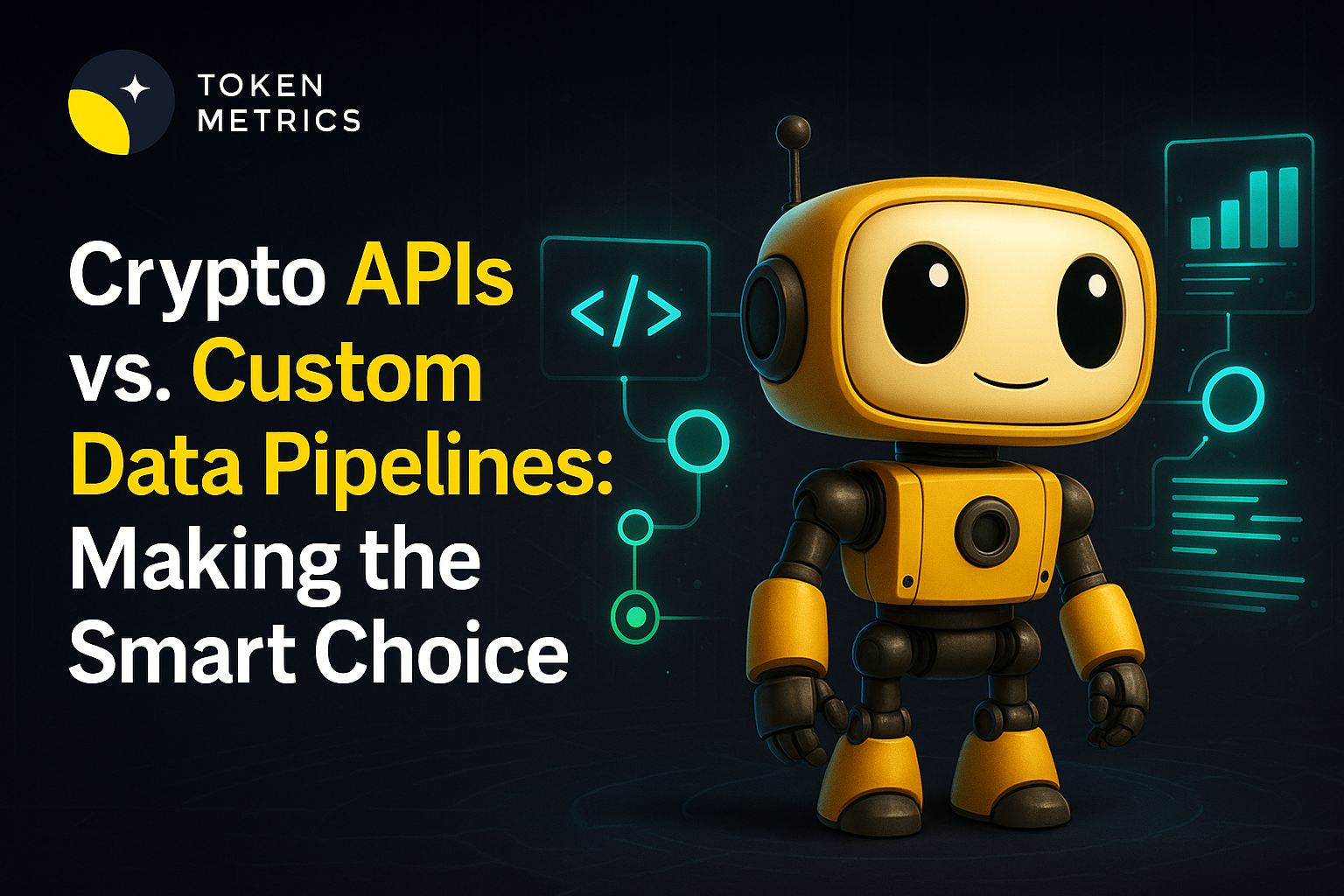
%201.svg)
%201.svg)
The explosive growth in cryptocurrency and blockchain technology has spawned a thriving ecosystem powered by data, automation, and real-time analytics. At the heart of this innovation are APIs—critical tools that connect crypto apps, trading platforms, wallets, and analytics dashboards to the blockchain or market data providers. But not all crypto APIs are created equal. Understanding the differences between REST, WebSocket, and GraphQL APIs can unlock new opportunities for enhanced performance, user experience, and scalability in your crypto projects.
APIs, or Application Programming Interfaces, act as bridges allowing different software systems to communicate with each other. In the context of cryptocurrency, APIs provide access to blockchain data, market price feeds, historical charts, transaction alerts, order book updates, and even smart contract interactions. Crypto APIs make it possible for developers and analysts to:
APIs differ in how they deliver information, their performance characteristics, and their flexibility. The three dominant types—REST, WebSocket, and GraphQL—each have unique strengths and best-fit scenarios.
REST (Representational State Transfer) APIs are among the most widely used in the crypto world. REST APIs rely on standard HTTP methods (like GET, POST, PUT, DELETE) to request or update data. Each endpoint URL represents a specific resource—for example, current price data for BTC/USD or historical trades.
REST remains the backbone of many data feeds, exchange integrations, and base-level blockchain explorers due to its universality and reliability.
For high-speed trading, instant alerts, or live order book monitoring, REST’s limitations become apparent. This is where WebSocket APIs excel. WebSockets enable persistent, bidirectional communication between client and server. Once the connection is established, data flows in real time—no need for repeated requests.
Any serious trading or live data dashboard in the crypto space will rely—at least in part—on WebSocket connections for their core user experience.
GraphQL, developed by Facebook, is a query language and runtime for APIs, and has gained traction in advanced crypto analytics and on-chain data services. Unlike REST, which returns fixed data structures, GraphQL allows clients to specify exactly what information they need in a single request.
GraphQL excels in scenarios demanding detailed, structured blockchain analytics, research dashboards, and customizable front ends that aggregate several data types.
Which API architecture should you use for your crypto development or analytical projects? The answer depends on multiple factors:
Many crypto apps combine these models—using REST for core data, WebSocket for live streams, and GraphQL for specialized research queries. Leading APIs—including Token Metrics—offer a blend of these approaches, allowing developers and analysts to match API features to use case requirements.
Build Smarter Crypto Apps & AI Agents with Token Metrics
Token Metrics provides real-time prices, trading signals, and on-chain insights all from one powerful API. Grab a Free API Key
REST APIs use single, on-demand requests for data, returning results each time a client asks. WebSocket APIs establish a persistent connection, enabling real-time, two-way updates perfect for live price feeds, trading platforms, and instant notifications.
GraphQL APIs are increasingly common for advanced research platforms, analytics dashboards, and projects needing complex, tailor-fit data queries. While REST and WebSocket remain more widespread, GraphQL’s adoption is growing rapidly among leading data providers such as Token Metrics.
Each API type has unique use cases—REST for simplicity and familiarity, WebSocket for real-time needs, and GraphQL for precision and customization. Many modern platforms offer a mix, allowing you to choose the most effective tool per feature.
Yes. Many robust crypto platforms and tools combine REST for standard data queries, WebSocket for live updates, and GraphQL for advanced analytics to provide comprehensive, efficient functionality.
Always secure API keys, use HTTPS, respect rate limits, and implement proper error handling. Choose reputable providers like Token Metrics for consistent data quality and platform security.
This article is for educational and informational purposes only. It does not constitute investment advice, trading recommendations, or offer guarantees of performance. Always conduct independent research and use APIs in accordance with their respective terms and conditions.
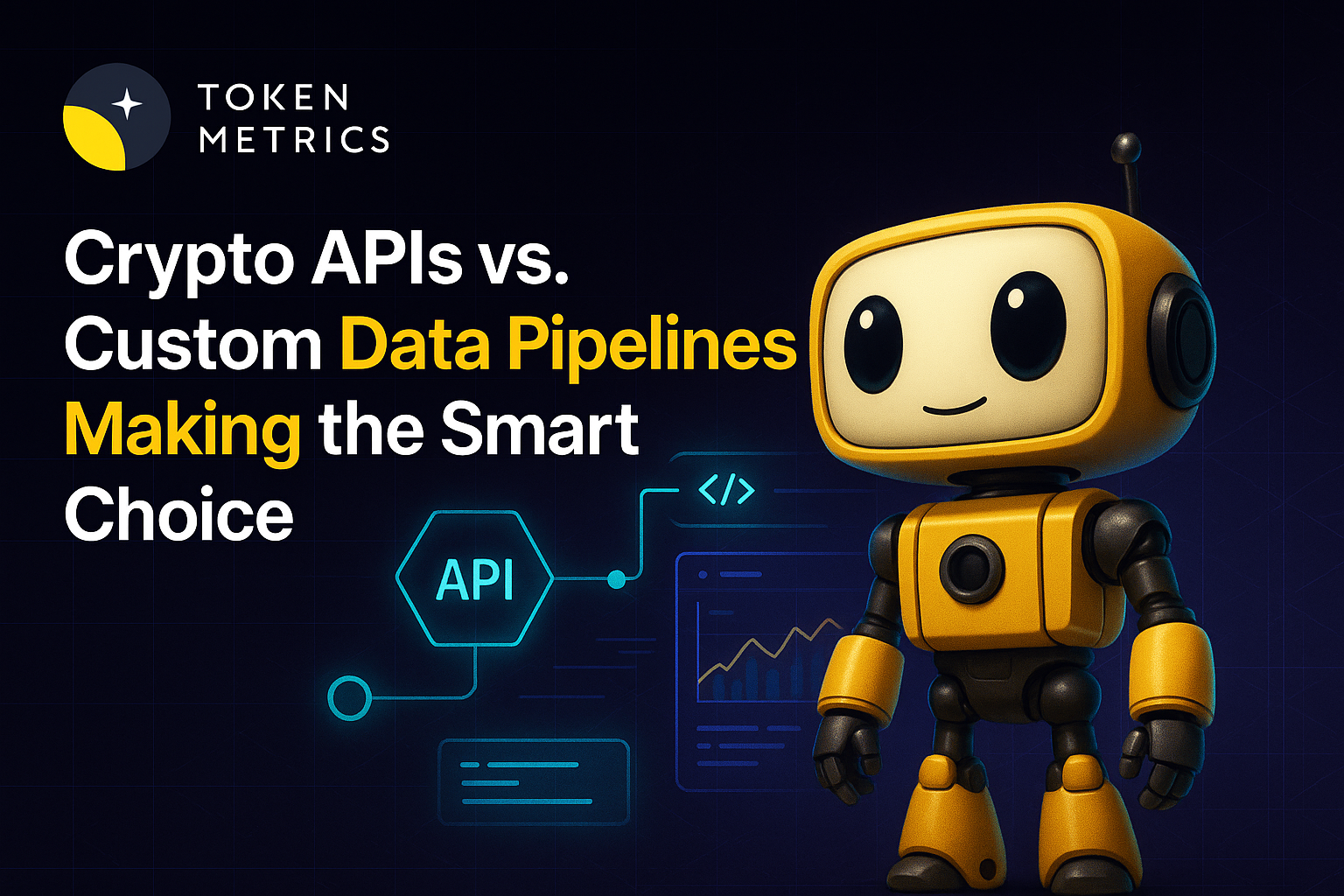
%201.svg)
%201.svg)
The world of crypto moves fast—data updates by the second and new protocols launch every week. Whether you're building trading bots, analytics dashboards, or AI-driven crypto research tools, your core infrastructure decision often comes down to this: should you use a pre-built crypto API or invest the time and resources to build your own data pipeline from scratch?
APIs, or Application Programming Interfaces, serve as gateways to real-time data and services. A crypto API provides standardized access to digital asset information such as price quotes, trading volumes, market histories, technical indicators, on-chain activity, and even AI-driven signals. Instead of scraping dozens of sources or building direct exchange integrations, developers and analysts get reliable, programmable access via a single, unified API. This foundation can power research dashboards, machine learning models, portfolio trackers, web or mobile apps, and more.
Constructing a DIY crypto data pipeline seems appealing for control and customization. However, the journey involves significant obstacles and ongoing effort:
For most users, these risks can outweigh the perceived benefits, especially as data needs become more sophisticated (e.g., real-time, AI-ready, or multi-chain inputs).
Leveraging a trusted crypto API provides significant advantages for both individual analysts and enterprise applications:
By leveraging APIs, developers and researchers capitalize on shared infrastructure, while gaining access to up-to-the-minute datasets crucial for machine learning, backtesting, and AI-driven workflows.
On the surface, building an in-house data solution seems cheaper, especially for technically capable teams. However, true cost calculations must account for:
In contrast, crypto API consumption usually follows a tiered, pay-as-you-grow model. For most projects, this delivers predictable costs versus the hidden, often escalating expenses of DIY approaches.
Many of today’s most innovative crypto tools—from algorithmic trading bots to predictive dashboards—rely on AI and big data analytics. These tools thrive on high-frequency, accurate, and broad market datasets. Building the data foundation in-house often diverts attention and resources from model design or product features.
API-first solutions enable seamless data ingestion for AI, supporting:
In the high-speed world of crypto, this agility and data quality often determine the difference between a useful tool and one that falls behind market realities.
Build Smarter Crypto Apps & AI Agents with Token Metrics
Token Metrics provides real-time prices, trading signals, and on-chain insights all from one powerful API. Grab a Free API Key
Crypto APIs can offer price quotes, historical data, order book snapshots, trading volumes, blockchain transactions, address activity, technical indicators, social mentions, and even AI-generated research signals—all packaged for easy retrieval and analysis.
Reputable API providers implement robust security measures, including end-to-end encryption, access controls, and continuous monitoring. Always research a provider’s security policies and consider limiting API permissions as a best practice.
Most advanced APIs provide real-time or near-real-time updates, typically every few seconds for price data. Some also offer streaming endpoints for continuous delivery. Always check the documentation for specific latency and refresh intervals.
Many APIs aggregate data from several exchanges, blockchains, or analytics providers, ensuring more comprehensive coverage and redundancy versus a single direct integration. This can improve data reliability and reduce downtime.
The Token Metrics API delivers a fusion of real-time market data, on-chain analytics, technical indicators, and algorithmic trading signals, all designed for reliability and easy integration by both developers and researchers.
This blog is for informational purposes only and should not be interpreted as financial, investment, or trading advice. The examples and providers mentioned are for educational comparison and analysis.

%201.svg)
%201.svg)
In the fast-moving world of cryptocurrency and blockchain, the foundation for many apps, exchanges, and research platforms is built on one crucial technology: APIs. If you’ve ever wondered how crypto apps access real-time prices or how traders tap into automated strategies, the answer is often a crypto API. But what exactly is a crypto API, how does it work, and why is it so indispensable?
An API, or Application Programming Interface, serves as a bridge allowing two software systems to communicate. In the context of cryptocurrency, a crypto API enables one platform (such as a website, trading bot, or analytical tool) to connect directly to blockchain networks, exchanges, and relevant databases. Developers and businesses use these APIs to access current market data, account information, blockchain analytics, or to execute operations such as placing a trade or transferring funds.
Crypto APIs are not exclusive to developers. Many common crypto services like portfolio trackers, news aggregators, and AI research tools all rely on APIs to source real-time data that users depend on every day. The use of APIs creates a standardized, efficient, and secure method for interacting with complex decentralized networks.
The primary function of a crypto API is to enable seamless and structured requests between a user-facing platform and deeper data sources, such as exchanges or blockchains. Here’s how the process typically unfolds:
Many APIs provide both public endpoints (such as market summaries or blockchain explorer queries) and private endpoints (like trading or wallet balance checks, which require stronger authentication).
The world of crypto APIs is broad, supporting a wide range of needs within the ecosystem. Here’s a breakdown of popular categories and their use cases:
These APIs underpin countless familiar crypto applications, from exchange mobile apps to AI-driven research platforms like Token Metrics.
Under the hood, most crypto APIs are RESTful, meaning they use standard HTTP methods (GET, POST, PUT, DELETE) to simplify requests and responses. However, some advanced use cases—such as streaming price updates or high-frequency trading—leverage WebSockets or gRPC for real-time, low-latency communication.
Security and authentication are paramount. API keys, OAuth authentication, and IP whitelisting help safeguard sensitive user actions and financial data. Good API providers also implement strict rate limits to ensure performance and fairness among users.
Integration often takes place through SDKs (software development kits) in popular languages like Python, JavaScript, or Java—making it easier for teams to embed crypto functionalities within apps, websites, or even AI agents.
The advantages offered by crypto APIs are profound for both developers and end users:
However, there are important considerations to evaluate when choosing or building a crypto API solution:
AI-powered crypto APIs, like those offered by Token Metrics, combine traditional market data with machine learning insights—unlocking deeper research capabilities for analysts, developers, and product teams.
Build Smarter Crypto Apps & AI Agents with Token Metrics
Token Metrics provides real-time prices, trading signals, and on-chain insights all from one powerful API. Grab a Free API Key
A crypto API lets you pull real-time market data, access blockchain analytics, monitor wallet balances, automate trades, aggregate research, and power custom dashboards. Developers and analysts use APIs to save time, improve data accuracy, and unlock advanced features in their applications.
Most crypto APIs offer a sign-up process where you’ll generate a unique API key. Popular providers like Token Metrics offer both free and premium tiers. Always follow the provider’s onboarding and security instructions when integrating with your software projects or research tools.
Reputable crypto APIs use industry-standard security protocols, such as HTTPS, API keys, and sometimes two-factor authentication or IP whitelisting. Users should store API keys securely and only grant the minimum required permissions for each application to minimize risk.
The best crypto API depends on your project’s needs. Consider factors such as supported exchanges, data refresh rates, reliability, available endpoints, support, and, when needed, AI or analytics features. Comparing providers based on usage requirements is recommended before integrating them into critical applications.
Most crypto APIs are open to developers, startups, and even individual hobbyists. However, some may restrict certain features or require KYC/AML processes for private account actions (such as trading or withdrawals). Always review the provider’s documentation and terms of service.
This content is for informational and educational purposes only. It does not constitute investment advice, offer, or solicitation. Users should exercise caution and conduct independent research before using any API or crypto tool. No endorsement of any specific API or product is implied. Token Metrics is not responsible for third-party API usage or integration outcomes.

%201.svg)
%201.svg)
In an era defined by rapid technological change and evolving cybersecurity threats, maintaining secure and resilient APIs is paramount. Key rotation, the periodic replacement of API credentials, is critical for keeping sensitive systems safe from unauthorized access. However, the challenge lies in updating or replacing API keys without causing disruptions or downtime for your users. How can you design a robust API key rotation strategy that’s both seamless and secure? In this article, we’ll dive deep into practical, real-world approaches for implementing key rotation in your API infrastructures with zero downtime, arming you with the know-how to fortify your applications while upholding uninterrupted service.
API keys are the digital credentials that regulate access to your platform’s endpoints. Over time, these keys can become vulnerable through accidental leaks, code exposure, or insider threats. Regular key rotation limits the lifespan of compromised credentials, minimizing potential attack windows and meeting the compliance demands of standards like SOC 2, HIPAA, and GDPR.
Key rotation can be straightforward for offline systems—but for APIs serving millions of daily requests or integrated into numerous clients, even brief downtime is unacceptable. A sophisticated rotation strategy is essential for:
Rotating keys while maintaining seamless API service is not trivial. Key challenges include:
Ignorance of these pitfalls can result in service downtime, frustrated users, and loss of trust—especially in the high-stakes world of crypto and financial APIs.
Best-in-class API architectures leverage systematic, automation-friendly methods for rotating keys. Here’s a step-by-step overview of how zero-downtime key rotation can be achieved:
This phased approach can be managed via API gateways, secrets managers (like AWS Secrets Manager or HashiCorp Vault), or custom automation pipelines. Automation is crucial for both security and operational scale.
Manual key rotation is error-prone and does not scale. Leading organizations use dedicated tools and APIs for secrets management, automating every phase of the lifecycle:
In the context of crypto APIs, rapid incident response is critical. Automated rotation empowers developers to replace at-risk credentials within minutes, eliminating the manual delays that adversaries can exploit.
Security and uptime are non-negotiable for APIs powering DeFi, exchanges, trading bots, or wallets. Effective rotation design patterns include:
By baking these patterns into your crypto API platform, you not only protect against security risks but also drive developer adoption through reliability and clarity.
Build Smarter Crypto Apps & AI Agents with Token Metrics
Token Metrics provides real-time prices, trading signals, and on-chain insights all from one powerful API. Grab a Free API Key
API key rotation is the process of periodically replacing digital credentials that control access to API endpoints. It is essential for limiting the risk window if a key is exposed and is a fundamental component of secure development and compliance programs.
By allowing both old and new keys to remain active during a transition period, clients can seamlessly migrate to the new key without interruption of service. Downtime only occurs when a key is disabled before all clients have switched over.
Yes. Modern API platforms often integrate with secrets management tools and automation scripts that generate, distribute, and retire keys according to policy—minimizing manual touchpoints and human error.
Continuous monitoring ensures that all clients are migrating as expected and alerts administrators to potential misconfigurations or unauthorized access attempts, enabling swift remediation before issues escalate into downtime.
Absolutely. Solutions like API gateways, cloud-native secrets managers (AWS, GCP, Azure), and specialized crypto API providers like Token Metrics make painless, automated key rotation achievable even at scale.
This article is for general informational purposes only and does not constitute investment, legal, or security advice. Always perform your own due diligence and consult with qualified professionals before implementing any security solution.


 Create Your Free Account
Create Your Free Account9450 SW Gemini Dr
PMB 59348
Beaverton, Oregon 97008-7105 US
.svg)




.png)
Token Metrics Media LLC is a regular publication of information, analysis, and commentary focused especially on blockchain technology and business, cryptocurrency, blockchain-based tokens, market trends, and trading strategies.
Token Metrics Media LLC does not provide individually tailored investment advice and does not take a subscriber’s or anyone’s personal circumstances into consideration when discussing investments; nor is Token Metrics Advisers LLC registered as an investment adviser or broker-dealer in any jurisdiction.
Information contained herein is not an offer or solicitation to buy, hold, or sell any security. The Token Metrics team has advised and invested in many blockchain companies. A complete list of their advisory roles and current holdings can be viewed here: https://tokenmetrics.com/disclosures.html/
Token Metrics Media LLC relies on information from various sources believed to be reliable, including clients and third parties, but cannot guarantee the accuracy and completeness of that information. Additionally, Token Metrics Media LLC does not provide tax advice, and investors are encouraged to consult with their personal tax advisors.
All investing involves risk, including the possible loss of money you invest, and past performance does not guarantee future performance. Ratings and price predictions are provided for informational and illustrative purposes, and may not reflect actual future performance.

